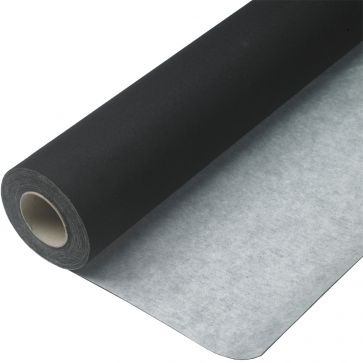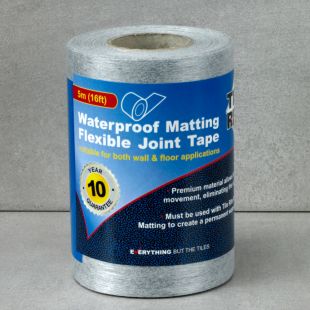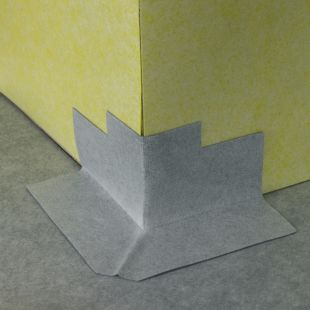Q. Which way round do you install the matting?
A. Fit the matting with the Black Fleece side down.
Q. Can you use a ready mixed waterproof adhesive to install the matting?
A. It is not recommended to use ready mixed adhesive as it requires air to cure and dry so a good bond is difï¬cult to achieve. The matting is waterproof and gives ready mixed adhesive little opportunity to get air exposure. A powdered adhesive is preferred as it dries chemically and doesn’t require exposure to air to cure.
Q. Does the adhesive used to install the tiles over the matting need to be the same as the adhesive used to install the matting itself?
A. If you need to use a flexible adhesive, i.e. when you are tiling onto wood, then to be safe you would use the same flexible adhesive on top of the matting. Although the matting compensates for shear forces and lateral movement it doesn’t compensate for vertical movement and flexing so a flexible adhesive is recommended above and below the matting.
Q. What thickness of adhesive is needed under the matting?
A. Our Tile Rite 4mm square notched trowel is recommended to be used to install the matting on the floor but the size of the trowel required to install the tiles on top of the matting is dictated by the size and location of the tiles themselves.
Q. Can the matting be laid over plywood?
A: Yes, not a problem, as long as it is WPB grade. A specialist adhesive should be used for wood application.
Q. Can the matting be installed onto floor boards?
A. As long as the substrate is structurally sound and ï¬rm. It is recommended to install a layer of plywood on top of the boards to ensure a flat surface and to make the substrate more secure and rigid.
Q. Can I install the matting outside on a concrete roof? Can I work in stages by installing a section of matting and then some tiles and then some more matting and so on?
A. Matting should be installed over the complete area ï¬rst and then the tiles because if you leave areas exposed without the matting you run the risk of water getting under the matting if it rains, which will then just sit there under the waterproof matting and eventually migrate into the concrete.
Q. Can the floor matting be used on the wall?
A. No the floor matting has a decoupling layer which if installed onto the wall may destruct and result in the tiles delaminating from the surface.
Q. Your leaflet and website installation instructions for this product say ‘Tile Immediately’. Not being a professional tiler, can I install the matting on the wall, leave it until the following day and then ï¬t the tiles?
A. Being able to tile immediately is one of the numerous advantages that our system has over competitors. It is not however a necessity and so tiling the next day is perfectly ï¬ne.
Q. If using Thermaboards, should they be ï¬tted on top of the matting or between the matting and the wire element?
A. Thermaboards have two functions, one is to provide insulation and increase the performance of an underfloor heating system and the other is to provide a strong and smooth surface to apply a floor covering onto. The matting therefore should be applied on top of the boards and underneath the heating as it will be much quicker and easier to apply the matting onto the smooth even surface of the boards. The integrity of the adhesive under the matting will also be preserved as the surface of the backer board is potentially much more rigid and secure than the surface underneath the boards so less likely to flex, break or crack the adhesive.
Q. Can the matting be applied over existing tiles or vinyl tiles?
A. It is not recommended. The substrate must always be strong, flat, even and load bearing to provide a good secure surface to install tiles onto. Vinyl tiles can be spongy and so will allow any new surface to move vertically on top, and potentially cracking to occur. Existing tiles may be uneven and insecure, so ensuring a flat solid layer over the top is very difï¬cult.
Q. It is impossible to get a water tight seal at the corner joints of the room as the jointing tape and corners are adhered with a water resistant adhesive. Please explain? A. The running water created by the shower is constantly flowing over the surface and away towards the drain. Any water that gets to the level of the substrate is not under enough pressure at the corners and cannot transverse through the adhesive and underneath the matting. To apply the joint tape and corners properly you must work all excess adhesive out of the joint and with pressure work the corner and joint ï¬rmly into the matting. You are left with a thin layer of adhesive that effectively fuses the ï¬bres of the wall / floor matting together with the jointing product. The lack of pressure and excellent surface bonding make it impossible for a water droplet to transverse through the 50mm overlapping joint. Thick layers and pools of adhesive, air pockets and less than 100% contact with the adhesive under the matting all compromise the competence of the system. The Tile Rite matting system is only recommended to be used in running water applications e.g. showers and not in areas that are subject to large amounts of standing water like swimming pools etc, as under high pressure, over time, the water may have enough force to penetrate the water resistant adhesive and transverse along the overlapping adhesive at the joint and thus escape to the substrate. The matting can however be used in standing water scenarios if the joints and edges are sealed with a suitable silicone sealant.
Q. The corners and jointing tape cannot be used with an off 90 degree corner, what is the solution?
A. If the corner is not square or curved then using a suitable silicone adhesive to seal the area is perfectly ï¬ne at the joints and edges of the matting.
Q. With regards to recommending BAL FastFlex with the matting system: FastFlex requires a solid bed tipped trowel to be used, how does effect the installation of the matting?
A. BAL does have a special trowel for use with their FastFlex product. The tipped trowel basically ensures the 100% coverage of the adhesive and stands on its own as a product for that reason. For optimum performance BAL FastFlex requires 100% coverage so it is recommended that this special trowel is used to ensure that. This trowel is not restricted to FastFlex and can be used with any of their adhesives. Any standard notched trowel however can be used with this as long as it is the correct size for the application. The nature of the matting is that it is a fabric and allows the user to really work the adhesive out from under the matting and ensure the 100% coverage that is needed. FastFlex is recommended as it eliminates the concern of whether you have the best adhesive for the substrate that you are working with, as BAL FastFlex can be used on almost any surface to adhere any type of tile!
Q. How do you apply matting around w/c pans and pedestals?
A. Any holes that you make in the matting must be ï¬lled with a suitable silicone or a pipe collar must be used. Always seal around the waste pipe of the toilet with a sealant. Again if you make a hole in the matting and do not use an element of the matting system to seal it, e.g. pipe collars, we cannot endorse the 100% waterproof guarantee. Usually toilets and basins are located away from the shower so water contact will be minimal.
Q. Will the matting crack bridge?
A. Yes, the matting will bridge substrate cracks up to 3mm.






